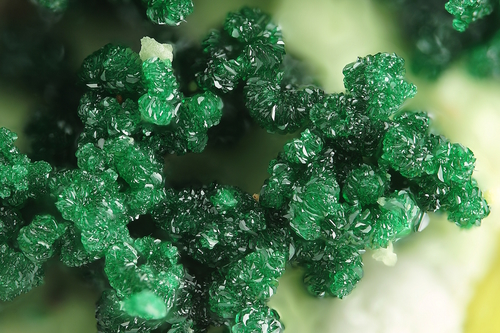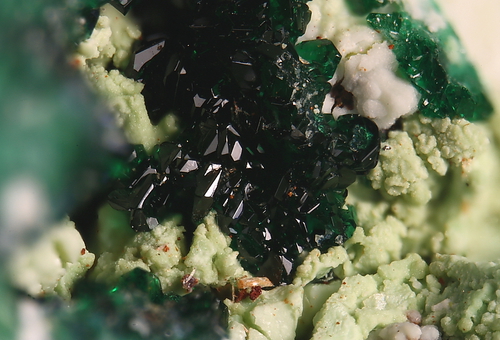Gillardite
A valid IMA mineral species
This page is currently not sponsored. Click here to sponsor this page.
About Gillardite
Formula:
Cu3Ni(OH)6Cl2
Colour:
Dark green
Lustre:
Vitreous
Hardness:
3
Specific Gravity:
3.76 (Calculated)
Crystal System:
Trigonal
Member of:
Name:
Named in 2007 by David M. Colchester, Peter Leverett, Meagan E. Clissold, Peter A. Williams, David E. Hibbs and Ernest H. Nickel in honour of Robert D. Gillard (23 August, 1936, London, England - ) professor, Department of Chemistry, Cardiff University, Wales, in recognition of his contributions to the field of inorganic chemistry.
Dimorph of:
Isostructural with:
Atacamite Group.
Closely related to paratacamite.
The Ni analogue of herbertsmithite and leverettite.
At least some of the gillardite from the type locality was originally considered to be "Ni-bearing paratacamite".
Closely related to paratacamite.
The Ni analogue of herbertsmithite and leverettite.
At least some of the gillardite from the type locality was originally considered to be "Ni-bearing paratacamite".
Unique Identifiers
Mindat ID:
31405
Long-form identifier:
mindat:1:1:31405:1
GUID
(UUID V4):
(UUID V4):
d1128e60-0e70-4d03-9e68-96d6a74d4f0a
IMA Classification of Gillardite
Classification of Gillardite
3.DA.10c
3 : HALIDES
D : Oxyhalides, hydroxyhalides and related double halides
A : With Cu, etc., without Pb
3 : HALIDES
D : Oxyhalides, hydroxyhalides and related double halides
A : With Cu, etc., without Pb
10.1.2.4
10 : OXYHALIDES AND HYDROXYHALIDES
1 : A2(O,OH)3Xq
10 : OXYHALIDES AND HYDROXYHALIDES
1 : A2(O,OH)3Xq
Mineral Symbols
As of 2021 there are now IMA–CNMNC approved mineral symbols (abbreviations) for each mineral species, useful for tables and diagrams.
| Symbol | Source | Reference |
|---|---|---|
| Gla | IMA–CNMNC | Warr, L.N. (2021). IMA–CNMNC approved mineral symbols. Mineralogical Magazine, 85(3), 291-320. doi:10.1180/mgm.2021.43 |
Physical Properties of Gillardite
Vitreous
Transparency:
Transparent
Colour:
Dark green
Comment:
Larger crystals are nearly black.
Streak:
Green
Hardness:
3 on Mohs scale
Tenacity:
Brittle
Cleavage:
Distinct/Good
On {101}.
On {101}.
Parting:
None observed.
Fracture:
Irregular/Uneven, Splintery
Density:
3.76 g/cm3 (Calculated)
Optical Data of Gillardite
Type:
Uniaxial (+)
RI values:
nω = 1.836(2) nε = 1.838(2)
Max Birefringence:
δ = 0.002

Image shows birefringence interference colour range (at 30µm thickness)
and does not take into account mineral colouration.
and does not take into account mineral colouration.
Surface Relief:
Very High
Dispersion:
None observed.
Pleochroism:
Not Visible
Chemistry of Gillardite
Mindat Formula:
Cu3Ni(OH)6Cl2
Crystallography of Gillardite
Crystal System:
Trigonal
Class (H-M):
3m (3 2/m) - Hexagonal Scalenohedral
Space Group:
R3m
Cell Parameters:
a = 6.8364 Å, c = 13.8459 Å
Ratio:
a:c = 1 : 2.025
Unit Cell V:
560.41 ų (Calculated from Unit Cell)
Morphology:
Equant, rhombohedral crystals showing the forms {101}, {021}, {001} and {100} (probable).
Twinning:
None observed.
Crystal Structure
Load
Unit Cell | Unit Cell Packed
2x2x2 | 3x3x3 | 4x4x4
Unit Cell | Unit Cell Packed
2x2x2 | 3x3x3 | 4x4x4
Show
Big Balls | Small Balls | Just Balls | Spacefill
Polyhedra Off | Si Polyhedra | All Polyhedra
Remove metal-metal sticks
Big Balls | Small Balls | Just Balls | Spacefill
Polyhedra Off | Si Polyhedra | All Polyhedra
Remove metal-metal sticks
Display Options
Black Background | White Background
Perspective On | Perspective Off
2D | Stereo | Red-Blue | Red-Cyan
Black Background | White Background
Perspective On | Perspective Off
2D | Stereo | Red-Blue | Red-Cyan
View
CIF File Best | x | y | z | a | b | c
CIF File Best | x | y | z | a | b | c
Rotation
Stop | Start
Stop | Start
Labels
Console Off | On | Grey | Yellow
Console Off | On | Grey | Yellow
Data courtesy of the American Mineralogist Crystal Structure Database. Click on an AMCSD ID to view structure
| ID | Species | Reference | Link | Year | Locality | Pressure (GPa) | Temp (K) |
|---|---|---|---|---|---|---|---|
| 0006139 | Gillardite | Clissold M E, Leverett P, Williams P A, Hibbs D E, Nickel E H (2007) The structure of gillardite, the Ni-analogue of herbertsmithite, from Widgiemooltha, Western Australia The Canadian Mineralogist 45 317-320 |  | 2007 | 132N deposit, Widgiemooltha, Australia | 0 | 293 |
CIF Raw Data - click here to close
X-Ray Powder Diffraction
Powder Diffraction Data:
| d-spacing | Intensity |
|---|---|
| 5.463 Å | (100) |
| 4.651 Å | (16) |
| 4.519 Å | (11) |
| 2.903 Å | (19) |
| 2.755 Å | (69) |
| 2.728 Å | (14) |
| 2.257 Å | (39) |
| 1.820 Å | (13) |
Geological Environment
Paragenetic Mode(s):
| Paragenetic Mode | Earliest Age (Ga) |
|---|---|
| Stage 7: Great Oxidation Event | <2.4 |
| 47a : [Near-surface hydration of prior minerals] | |
| 47g : [Halogen-bearing surface weathering minerals] | |
| Stage 10a: Neoproterozoic oxygenation/terrestrial biosphere | <0.6 |
| 50 : Coal and/or oil shale minerals | <0.36 |
Type Occurrence of Gillardite
General Appearance of Type Material:
Aggregates of equant, rhombohedral crystals up to 0.5 mm.
Place of Conservation of Type Material:
Gartrell Collection, Department of Earth and Planetary Sciences, Western Australian Museum, Perth Cultural Centre, Perth, Australia, number 8774.
Geological Setting of Type Material:
Silicified ferruginous gossan.
Associated Minerals at Type Locality:
Synonyms of Gillardite
Other Language Names for Gillardite
Simplified Chinese:氯羟镍铜石
Relationship of Gillardite to other Species
Member of:
Other Members of this group:
| Atacamite | Cu2(OH)3Cl | Orth. mmm (2/m 2/m 2/m) : Pnma |
| Botallackite | Cu2(OH)3Cl | Mon. 2/m : P21/m |
| Clinoatacamite | Cu2(OH)3Cl | Mon. 2/m |
| Haydeeite | Cu3Mg(OH)6Cl2 | Trig. 3m (3 2/m) : P3m1 |
| Herbertsmithite | Cu3Zn(OH)6Cl2 | Trig. 3m (3 2/m) : R3m |
| Hibbingite | Fe2+2(OH)3Cl | Orth. mmm (2/m 2/m 2/m) : Pnma |
| Iyoite | MnCuCl(OH)3 | Mon. 2/m : P21/m |
| Kapellasite | Cu3Zn(OH)6Cl2 | Trig. 3m (3 2/m) : P3m1 |
| Kempite | Mn2+2(OH)3Cl | Orth. mmm (2/m 2/m 2/m) : Pnma |
| Leverettite | Cu3Co(OH)6Cl2 | Trig. 3 : R3 |
| Misakiite | Cu3Mn(OH)6Cl2 | Trig. 3m (3 2/m) : P3m1 |
| Paratacamite | Cu3(Cu,Zn)(OH)6Cl2 | Trig. 3 : R3 |
| Paratacamite-(Mg) | Cu3(Mg,Cu)(OH)6Cl2 | Trig. 3 : R3 |
| Paratacamite-(Ni) | Cu3(Ni,Cu)(OH)6Cl2 | Trig. 3 : R3 |
| Tondiite | Cu3Mg(OH)6Cl2 | Trig. 3m (3 2/m) : R3m |
| Unnamed (Cu-Zn Chloride Hydroxide) | CuZnCl(OH)3 | Mon. 2/m : P21/m |
Common Associates
Associated Minerals Based on Photo Data:
| 31 photos of Gillardite associated with Gaspéite | NiCO3 |
| 11 photos of Gillardite associated with Gypsum | CaSO4 · 2H2O |
| 5 photos of Gillardite associated with Hydrohonessite | (Ni1-xFe3+x)(OH)2(SO4)x/2 · nH2O |
| 2 photos of Gillardite associated with Quartz | SiO2 |
| 1 photo of Gillardite associated with Widgiemoolthalite | Ni5(CO3)4(OH)2 · 5H2O |
| 1 photo of Gillardite associated with Magnesite | MgCO3 |
| 1 photo of Gillardite associated with Tremolite | ◻Ca2Mg5(Si8O22)(OH)2 |
Related Minerals - Strunz-mindat Grouping
| 3.DA. | Centennialite | CaCu3Cl2(OH)6 · nH2O (n ~ 0.7) |
| 3.DA. | Muonionalustaite | Ni3(OH)4Cl2 · 4H2O |
| 3.DA. | Parahibbingite | Fe2(OH)3Cl |
| 3.DA. | Bounahasite | Cu+Cu2+2(OH)3Cl2 |
| 3.DA.05 | Melanothallite | Cu2Cl2O |
| 3.DA.10a | Atacamite | Cu2(OH)3Cl |
| 3.DA.10b | Botallackite | Cu2(OH)3Cl |
| 3.DA.10b | Clinoatacamite | Cu2(OH)3Cl |
| 3.DA.10a | Hibbingite | Fe2+2(OH)3Cl |
| 3.DA.10a | Kempite | Mn2+2(OH)3Cl |
| 3.DA.10c | Kuliginite | Fe3Mg(OH)6Cl2 |
| 3.DA.10c | Paratacamite | Cu3(Cu,Zn)(OH)6Cl2 |
| 3.DA.10b | Belloite | Cu(OH)Cl |
| 3.DA.10c | Herbertsmithite | Cu3Zn(OH)6Cl2 |
| 3.DA.10c | Kapellasite | Cu3Zn(OH)6Cl2 |
| 3.DA.10c | Haydeeite | Cu3Mg(OH)6Cl2 |
| 3.DA.10c | Leverettite | Cu3Co(OH)6Cl2 |
| 3.DA.10c | Paratacamite-(Ni) | Cu3(Ni,Cu)(OH)6Cl2 |
| 3.DA.10c | Tondiite | Cu3Mg(OH)6Cl2 |
| 3.DA.10c | Misakiite | Cu3Mn(OH)6Cl2 |
| 3.DA.10b | Iyoite | MnCuCl(OH)3 |
| 3.DA.10b | Unnamed (Cu-Zn Chloride Hydroxide) | CuZnCl(OH)3 |
| 3.DA.15 | Claringbullite | Cu4ClF(OH)6 |
| 3.DA.15 | Barlowite | Cu4BrF(OH)6 |
| 3.DA.20 | Simonkolleite | Zn5Cl2(OH)8 · H2O |
| 3.DA.25 | Buttgenbachite | Cu19(NO3)2(OH)32Cl4 · 2H2O |
| 3.DA.25 | Connellite | Cu19(SO4)(OH)32Cl4 · 3H2O |
| 3.DA.30 | Abhurite | Sn21Cl16(OH)14O6 |
| 3.DA.35 | Ponomarevite | K4Cu4Cl10O |
| 3.DA.40 | Anthonyite | Cu(OH,Cl)2 · 3H2O |
| 3.DA.40 | Calumetite | CaCu4(OH)8Cl2 · 3.5H2O |
| 3.DA.45 | Khaidarkanite | Cu4Al3(OH)14F3 · 2H2O |
| 3.DA.50 | Bobkingite | Cu5Cl2(OH)8 · 2H2O |
| 3.DA.55 | Avdoninite | K2Cu5(OH)4Cl8 · H2O |
| 3.DA.60 | Droninoite | Ni6Fe3+2(OH)16Cl2 · 4H2O |
| 3.DA.70 | Chrysothallite | K6Cu6Tl3+Cl17(OH)4 · H2O |
| 3.DA.70 | Dioskouriite | CaCu4Cl6(OH)4 · 4H2O |
| 3.DA.75 | Feodosiyite | Cu11Mg2Cl18(OH)8 · 16H2O |
| 3.DA.80 | Romanorlovite | K8Cu6Cl17(OH)3 |
Fluorescence of Gillardite
Not fluorescent.
Other Information
Thermal Behaviour:
The mineral decomposes with loss of water between 150 and 300°C.
Health Risks:
No information on health risks for this material has been entered into the database. You should always treat mineral specimens with care.
Internet Links for Gillardite
mindat.org URL:
https://www.mindat.org/min-31405.html
Please feel free to link to this page.
Please feel free to link to this page.
Search Engines:
External Links:
Mineral Dealers:
References for Gillardite
Reference List:
Localities for Gillardite
Locality List
 - This locality has map coordinates listed.
- This locality has map coordinates listed.
 - This locality has estimated coordinates.
ⓘ - Click for references and further information on this occurrence.
? - Indicates mineral may be doubtful at this locality.
- This locality has estimated coordinates.
ⓘ - Click for references and further information on this occurrence.
? - Indicates mineral may be doubtful at this locality.
 - Good crystals or important locality for species.
- Good crystals or important locality for species.
 - World class for species or very significant.
(TL) - Type Locality for a valid mineral species.
(FRL) - First Recorded Locality for everything else (eg varieties).
- World class for species or very significant.
(TL) - Type Locality for a valid mineral species.
(FRL) - First Recorded Locality for everything else (eg varieties).
All localities listed without proper references should be considered as questionable.
Australia (TL) | |
| Colchester et al. (2007) +1 other reference |
| Sciberras et al. (2013) |
Germany | |
| Witzke (2012) |
Quick NavTopAbout GillarditeUnique IdentifiersIMA Classification Classification Mineral SymbolsPhysical Properties Optical Data Chemistry Crystallography Crystal StructureX-Ray Powder DiffractionGeological EnvironmentType Occurrence SynonymsOther LanguagesRelationshipsCommon AssociatesStrunz-MindatFluorescence Other InformationInternet Links References Localities Locality List






 symbol to view information about a locality.
The
symbol to view information about a locality.
The 



132 North Ni Mine, Widgiemooltha, Coolgardie Shire, Western Australia, Australia